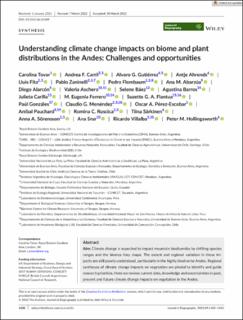| dc.description.abstract | Aim: Climate change is expected to impact mountain biodiversity by shifting species ranges and the biomes they shape. The extent and regional variation in these impacts are still poorly understood, particularly in the highly biodiverse Andes. Regional syntheses of climate change impacts on vegetation are pivotal to identify and guide research priorities. Here we review current data, knowledge and uncertainties in past, present and future climate change impacts on vegetation in the Andes.
Location: Andes.
Taxon: Plants.
Methods: We (i) conducted a literature review on Andean vegetation responses to past and contemporary climatic change, (ii) analysed future climate projections for different elevations and slope orientations at 19 Andean locations using an ensemble of model outputs from the Coupled Model Intercomparison Project 5, and (iii) calculated changes in the suitable climate envelope area of Andean biomes and compared these results to studies that used species distribution models.
Results: Future climatic changes (2040–2070) are projected to be stronger at high-elevation areas in the tropical Andes (up to 4°C under RCP 8.5), while in the temperate Andes temperature increases are projected to be up to 2°C. Under this worst-case scenario, temperate deciduous forests and the grasslands/steppes from the Central and Southern Andes are predicted to show the greatest losses of suitable climatic space (30% and 17%–23%, respectively). The high vulnerability of these biomes contrasts with the low attention from researchers modelling Andean species distributions. Critical knowledge gaps include a lack of an Andean wide plant checklist, insufficient density of weather stations at high-elevation areas, a lack of high-resolution climatologies that accommodates the Andes' complex topography and climatic processes, insufficient data to model demographic and ecological processes, and low use of palaeo data for distribution modelling.
Main conclusions: Climate change is likely to profoundly affect the extent and composition of Andean biomes. Temperate Andean biomes in particular are susceptible to substantial area contractions. There are, however, considerable challenges and uncertainties in modelling species and biome responses and a pressing need for a region-wide approach to address knowledge gaps and improve understanding and monitoring of climate change impacts in these globally important biomes. | en_US |

